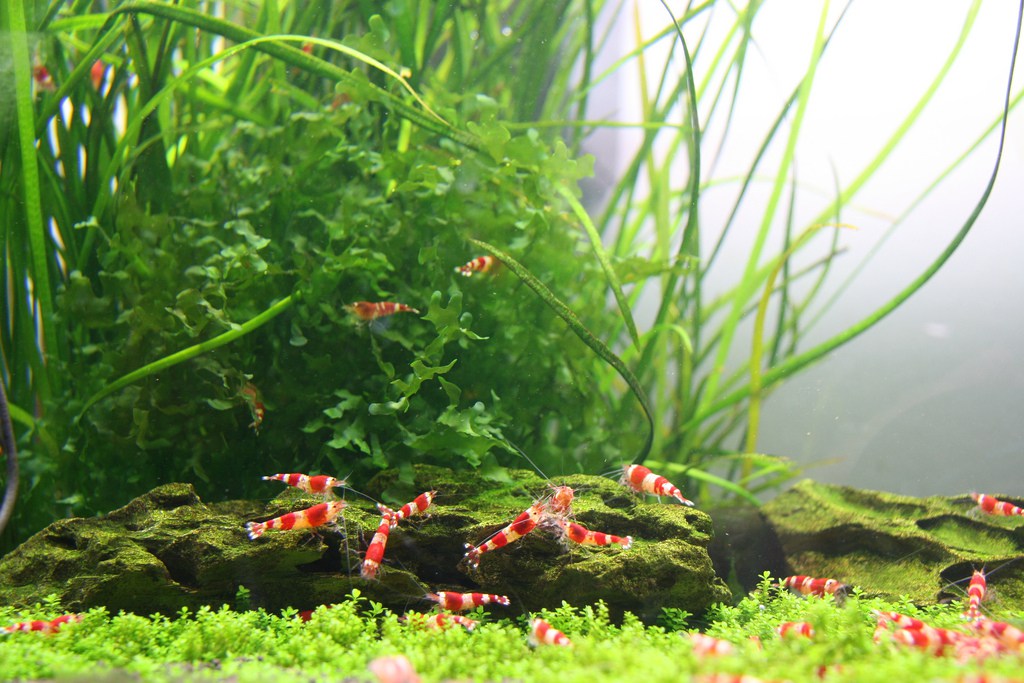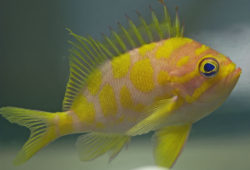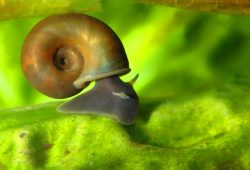Keeping fan shrimps
In the article I’m going to tell you about Keeping fan shrimps. Shrimps are enjoying something of a rebirth at the moment as more and more people look to include them in their tanks.

Yet although dwarf shrimps tend to be the most popular, their larger relatives, the fan or filter-feeding shrimps, tend to be ignored as they do not enjoy the same reputation as regards algae eating and have somewhat specialist needs.
Yet with the correct know-how, these creatures demonstrate fascinating types of behaviour and, thanks to their high life expectancy, are long-lasting aquarium dwellers.
Their common names derive from their highly specialised form of ingestion. Their bristles on the chela (claw), which are typical to the family, are much longer than with dwarf shrimps and can be shaped like a spread-out fan.
These shrimps use their fan-like appendages to filter very fine floating food items such as mosquito larvae, Daphnia and Cyclops, as well as small algae particles from the current.
Not to worry, the specially shaped chelae do not pose a danger to fish.
Contents
Mountain streams
These shrimp typically live in small, fast-flowing to rapid mountainous streams in tropical areas. They grip stony bedrock, directly in the current, with their powerful claws and legs.
They are rarely seen on sandy or silty subsoil, which is typical of slower-flowing sections close to river estuaries.
This preference for strong currents and oxygen-rich water must be taken into consideration when keeping them in an aquarium. So in addition to filtering, it’s a very good idea to use a current pump to keep the water in constant circulation.
Due to their adaptation to small, fast-flowing waters, these shrimp have a very high oxygen demand, which is virtually impossible to recreate in a densely planted aquarium. Needless to say, in the wild their habitats do not feature any high-growing aquatic plants.
Atya mollucensis is the most widely sold fan shrimp in UK shops.
Daytime shelter
Throughout the day, they usually seek refuge under large stones or in piles of dead wood.
For this reason, most filter-feeding shrimp species are rarely seen in tanks set up specifically for the species, despite their size (some species of the Atya genus reach a length of 15 cm/6”).
They only come out of hiding at twilight or in darkness in order to capture floating food from the current at favourable positions.
This is also an indication of their adaptation to the conditions in the wild.
Filter feeding
In an intact flowing body of water, the amount of floating micro-organisms escalates at night because the danger of being eaten by predators such as fish or insectivorous aquatic birds is far reduced.
As such, feeding in the aquarium with the finest living, frozen or dried foods should mainly be carried out at night.
Specialists might think about employing a feeding device to release several small portions of food into the current throughout these dark hours.
Socialisation with current-loving species, such as some Peppered catfish or characins, is certainly possible.
However, filter-feeding shrimps should not be socialised with intrusive fish species such as Guppies or Black mollies because these fish enjoying plucking the shrimps’ long antennae and bristles, which is certainly a stress factor for these creatures.
All filter-feeding shrimps belong to the Atyidae family and its subfamily, Atyinae. All genera live in inland flowing waters – these creatures cannot be found in brackish or marine waters.
The large species of the Atya, Atyopsis and Atyoida genera have mainly gained importance in aquaristics. Smaller species such as creatures from the Micratya genera are only kept by a handful of specialists.
From a taxonomic point of view, this genus does not belong to the filter-feeding shrimps in the narrow sense, but to the Caridellinae subfamily.
Atya gabonensis
The blue Giant African filter shrimp originates from West African and South American streams that flow into the Atlantic. Reaching a size of 15 cm/6”, these creatures have a conspicuously furrowed, wrinkly carapace, which makes them easily distinguishable from all other filter-feeding shrimps.
Unlike the name suggests, not all specimens are blue. Grey and, in the case of older creatures, black colouring are much more frequent.
Sometimes completely white creatures can also be found in aquariums after the creatures have shed their skin. The reason for this loss of colour remains a mystery
As with all species of the genus, A. gabonensis requires very fine floating food in the form of algae powder, dried small crustaceans (Daphnia, Cyclops), dried mosquito larvae or finely grated dried food, which should be added to the aquarium shortly before switching off the aquarium lighting so that the nocturnal creatures are able to find sufficient food.
Instead of using a filter, a powerful current pump should be used to ensure the necessary water circulation and to prevent the fine food items being removed prematurely from the water.
If there is insufficient floating food for the shrimps, they will also pick up food that has sunk to the ground. This, however, can lead to the intense wearing of the fan bristols.
Atya scabra
This species is only slightly smaller than its close relative, A. gabonensis. They live in the same waters as the aforementioned species, but its habitat also penetrates somewhat further north, where they can also be found in Central America and the offshore islands.
Although these creatures do not have the wrinkly carapace surface of the A. gabonensis, the bodies of older specimens have a dense covering of fine knots, which gives them a rough surface.
A. scabra demonstrates an interesting colour change. While the bodies of younger specimens are green to greyish-green, their colours change to red/reddish-brown from a certain body size. Old specimens are generally coloured dark brown.
As with all other filter-feeding shrimps, A. scabra cannot reproduce in freshwater aquariums.
This is because the larvae, which hatch out of tiny eggs, need to pass through several stages in brackish or marine water before the young creatures ascend along the streams to higher freshwater biotopes.
There they live as adult creatures and where, after mating, the females release their larvae which are then swept into the sea along with the current.
Atyoida pilipes
For a few months now, a light-coloured filter-feeding shrimp from Indonesia and New Guinea has been on sale in the pet shops.
These shrimps are similar in shape and size to the Asian filter shrimp, but their microscopic build and colouring are very different.
What’s especially interesting about them is how they hatch and first develop into males that have chelae with short bristles, which they use to strip young organisms from surfaces.
But from a certain body size or age, the creatures develop into functional females, which then have chelas typical for filter-feeding shrimps which filter the food from the current. Unfortunately, only the larger female creatures are usually offered in pet shops.
Atyopsis moluccensis
While both described species of the Atya genus reside in rivers and streams that flow into the Atlantic Ocean, the Asian filter shrimp originates from the Asian area of the Indo-Pacific.
With a maximum body size of 9 cm/3½”, the creatures are considerably smaller than the Giant African filter shrimps. However, they have beautiful colouring – green or light brown, often with a fine, clear stripe down the length of the body.
And what’s more, these creatures are less shy than their Atlantic relatives and can be observed more frequently in the day time, filtering for food.
As with the Atya species, their food should consist of a varied mixture of fine plant and animal substances, which should be placed in the water current.
Besides the Asian filter shrimp, the closely related A. spinipes is sometimes also on offer in pet shops.
Without the aid of a microscope, it is impossible to tell them apart.
It is also impossible to breed this species in freshwater, so all creatures that you see in shops have been captured from the wild. Serious attempts to breed these species in brackish water will be of interest for ecological reasons.
Micratya poeyi
These beautiful creatures, which are around the same size as dwarf shrimps, do not belong to the filter-feeding shrimps from a purely taxonomic point of view.
However, they also have chela with long bristles and employ the same filtering method of feeding.
These creatures originate from streams that flow into the Caribbean and have only rarely been offered in the ornamental fish trade.
Micratya also require strong currents in the aquarium. The volume of the tank does not need to be as high as with the larger filter-feeding shrimps.
This article was first published in the August 2007 issue of Practical Fishkeeping magazine. The images are by Chris Lukhaup.



